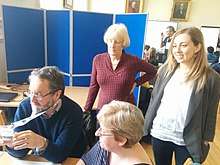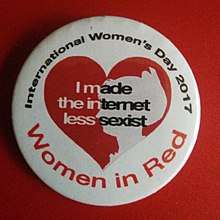Women in Red
Women in Red is a WikiProject addressing the current gender bias in Wikipedia content. The project focuses on creating content regarding women's biographies, women's works, and women's issues.
 Logo | |
| Abbreviation | WiR |
|---|---|
| Formation | 2015 |
| Founder |
|
| Methods | Edit-a-thons |
| Website | WikiProject Women in Red |
The project is named after the hyperlinks in existing Wikipedia articles that display in red to indicate that the linked article is missing.
History
Women in Red was conceived by volunteer Wikipedia editor Roger Bamkin in 2015, and volunteer editor Rosie Stephenson-Goodknight joined forces soon thereafter. Bamkin had initially coined a name for the project, "Project XX", but that was quickly scuttled in favor of WikiProject Women in Red.[1]
After the project was up and running, volunteer editor Emily Temple-Wood signed on. Her specialty is adding a new Wikipedia article about a female scientist each time somebody harasses her about her volunteer editing efforts.[1]
At Wikimania 2016, in Esino Lario, Italy, Jimmy Wales, who co-founded Wikipedia in 2001, named Stephenson-Goodknight and Temple-Woods the Wikipedians of the Year, for the prior 12 months, for their effort to fill the gender chasm.[1]
Methods


Women in Red conducts Wikipedia edit-a-thons in cities around the world, and continuously hosts a virtual one.[2] The all-day in-person edit-a-thons are focused events conducted to train new contributors so that the Wikipedia gender gap can become narrower and include more content on notable women.[3] Another goal is to increase the number of female editors. Though Wikipedia is "the free encyclopedia that anyone can edit", as at 2015 about only 10 percent of editors were women.[4][5][6][3]
The Women in Red participants help to collate 150 worklists of red linked articles to make it easier to find and create the missing articles.[7]
As of December 22, 2016, Women in Red volunteer editors added over 45,000 articles, and the percentage of tallied articles increased marginally to 16.8 percent of English-language biographies (from 15 percent in July 2015).[8]
See also
- Women in Red WikiProject
- Gender bias on Wikipedia
References
- Redden, Molly (March 19, 2016). "Women in science on Wikipedia: will we ever fill the information gap?". The Guardian. Archived from the original on November 8, 2017. Retrieved November 25, 2017.
- Chemistry, The Royal Society of (August 18, 2017). "Improving gender balance on Wikipedia". www.rsc.org. Archived from the original on October 12, 2017. Retrieved November 25, 2017.
- "Wikipedia editing marathons add women's voices to online resource". Houston Chronicle. Archived from the original on November 9, 2017. Retrieved November 25, 2017.
- Andrew Lih (June 20, 2015). "Can Wikipedia Survive?". www.nytimes.com. Washington. Archived from the original on June 21, 2015. Retrieved June 21, 2015.
...the considerable and often-noted gender gap among Wikipedia editors; in 2011, less than 15 percent were women.
- Statistics based on Wikimedia Foundation Wikipedia editor surveys 2011 (Nov. 2010-April 2011) and November 2011 Archived June 5, 2016, at the Wayback Machine (April – October 2011)
- Hill, Benjamin Mako; Shaw, Aaron; Sánchez, Angel (June 26, 2013). "The Wikipedia Gender Gap Revisited: Characterizing Survey Response Bias with Propensity Score Estimation". PLoS ONE. 8 (6): e65782. Bibcode:2013PLoSO...865782H. doi:10.1371/journal.pone.0065782. PMC 3694126. PMID 23840366. Archived from the original on December 14, 2014.
- Stein, Lucia (December 9, 2016). "Wikipedia edit-a-thon tackles internet gender gap". ABC News. Archived from the original on March 7, 2017. Retrieved November 25, 2017.
- Kessenides, Dimitra; Chafkin, Max (December 22, 2016). "Is Wikipedia Woke? The ubiquitous reference site tries to expand its editor ranks beyond the Comic Con set". Bloomberg.com. Archived from the original on September 23, 2017. Retrieved November 25, 2017.
External links
| Wikimedia Commons has media related to WikiProject Women in Red. |
- BBC – Viewpoint: How I tackle Wiki gender gap one article at a time — By Rosie Stephenson-Goodknight – Wikipedian of the Year 2016 — 7 December 2016